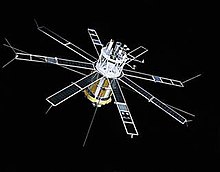CORONAS programme
Complex Orbital Observations Near-Earth of Activity of the Sun, or CORONAS, was a Russian Solar observation satellite programme. Three satellites were launched: CORONAS-I, CORONAS-F, and CORONAS-Photon.
CORONAS-I
[edit]
CORONAS-I was launched in 1994.[1]
The satellites had 12 instrumenents:[1]
- TEREK-C - Solar XUV Telescope/Coronagraph
- RES-C - Solar X-ray Spectral Polarimeter
- DIOGENESS - Diagnostic of Energy Sources and Sinks in Flares
- HELICON - Solar X-ray and gamma-ray Scintillation Spectrometer
- IRIS - Solar Burst Spectrometer
- SUFR-Sp-C - Solar UV Radiometer
- VUSS - Vacuum UV Solar spectrum
- DIFOS - Solar Flux Optical Photometer
- SORS - Solar Radiospectrometer
- SKL-particles - Solar Cosmic-ray Spectrometer Complex - particles
- AVS - Amplitude-time Spectrum Analyser
- SKL-rad - Solar Cosmic-ray Spectrometer Complex - radiation
CORONAS-F
[edit]
CORONAS-I was launched in 2001 and worked until 2005.[2][3]
The satellites had 16 instrumenents:[2]
- TEREK-C - Solar XUV Telescope/Coronagraph
- RES-C - Solar X-ray Spectral Polarimeter
- DIOGENESS - Diagnostic of Energy Sources and Sinks in Flares
- HELICON - Solar X-ray and gamma-ray Scintillation Spectrometer
- IRIS - Solar Burst Spectrometer
- SUFR-Sp-C - Solar UV Radiometer
- VUSS - Vacuum UV Solar spectrum
- DIFOS - Solar Flux Optical Photometer
- SORS - Solar Radiospectrometer
- SKL-particles - Solar Cosmic-ray Spectrometer Complex - particles
- SPR-N - Solar X-ray Polarimeter
- RESIK - X-ray Spectrometer
- AVS - Amplitude-time Spectrum Analyser
- RPS-1 - X-ray Semi-conductor Spectrometer
- IMAP-5 - Three-axis Magnetometer
- SKL-rad - Solar Cosmic-ray Spectrometer Complex - radiation
CORONAS-Photon
[edit]
CORONAS-Photon was launched on 30 January 2009, from Plesetsk Cosmodrome, aboard the final flight of the Tsyklon-3 rocket. On 1 December 2009 all scientific instruments on the satellite were turned off due to the problems with power supply that were caused by a design flaw.[4][5] On 18 April 2010 the creators of the satellite announced it was lost "with a good deal of certainty".[6][7]
The satellite had 11 instruments:[8]
- Natalya-2M-rad - High energy radiation spectrometer - radiation
- RT-2 - Roentgen Telescope-2
- Penguin-M - Hard X-ray polarimeter-spectrometer
- Konus-RF - X-ray and gamma-ray spectrometer
- BRM - Fast X-ray Monitor
- PHOKA - Multi-channel ultraviolet monitor
- TESIS - Telescope-spectrometer for imaging solar spectroscopy in X-rays
- Electron-M-PESCA - Charged particle analyzer
- STEP-F - Satellite telescope of electrons and protons
- Natalya-2M-particles - High energy radiation spectrometer - particles
- SM-8M Magnetometer
References
[edit]- ^ a b "WMO OSCAR | Satellite: Coronas-I". space.oscar.wmo.int. Retrieved 22 October 2024.
- ^ a b "WMO OSCAR | Satellite: Coronas-F". space.oscar.wmo.int. Retrieved 22 October 2024.
- ^ Kuznetsov, V. D. (October 22, 2014). "CORONAS-F Project: The Study of Solar Activity and Its Effects on the Earth". In Kuznetsov, Vladimir (ed.). The Coronas-F Space Mission: Key Results for Solar Terrestrial Physics. Astrophysics and Space Science Library. Vol. 400. Springer. pp. 1–26. doi:10.1007/978-3-642-39268-9_1. ISBN 978-3-642-39268-9 – via Springer Link.
- ^ Спутник "Коронас-Фотон" не работает из-за проблем с питанием [Coronas-Foton satellite doesn't work due to the problems with the power supply] (in Russian). RIA Novosti. 2009-12-11.
- ^ "Коронас-Фотон" сломался из-за переоценки ресурса аккумуляторов [Coronas-Foton broke down because battery resource was underestimated] (in Russian). RIA Novosti. 2010-01-11.
- ^ КОРОНАС-ФОТОН, по-видимому, умер Archived 2010-04-22 at the Wayback Machine [Coronas-Foton is apparently dead] (in Russian). Official press release of the Laboratory of X-Ray Astronomy of the Sun of the Russian Academy of Sciences.
- ^ Солнце не смогло оживить научный спутник "Коронас-Фотон" [The Sun couldn't revive the Coronas-Foton scientific satellite] (in Russian). RIA Novosti. 2010-04-19.
- ^ "WMO OSCAR | Satellite: Coronas-Photon". space.oscar.wmo.int. Retrieved 22 October 2024.
